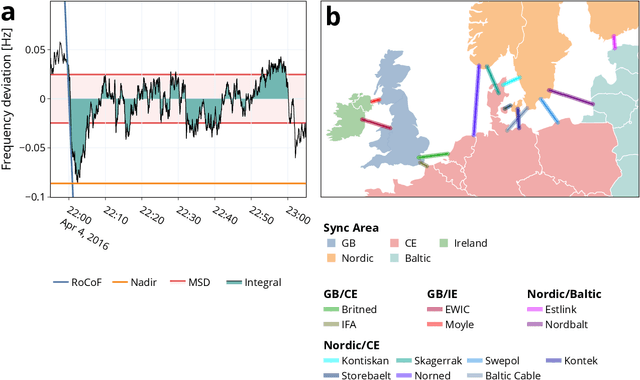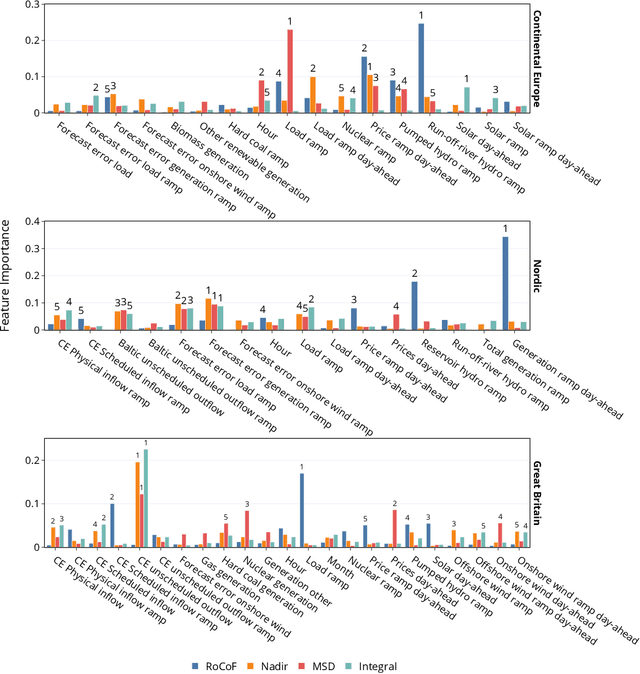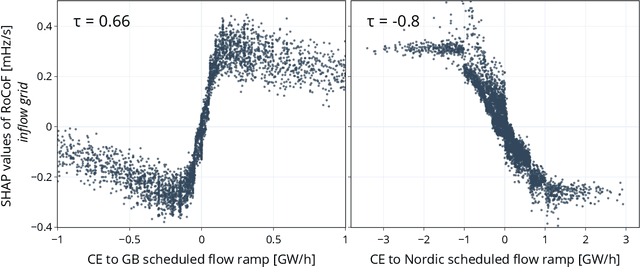Sebastian Pütz
Probabilistic Forecasting of Day-Ahead Electricity Prices and their Volatility with LSTMs
Oct 05, 2023Abstract:Accurate forecasts of electricity prices are crucial for the management of electric power systems and the development of smart applications. European electricity prices have risen substantially and became highly volatile after the Russian invasion of Ukraine, challenging established forecasting methods. Here, we present a Long Short-Term Memory (LSTM) model for the German-Luxembourg day-ahead electricity prices addressing these challenges. The recurrent structure of the LSTM allows the model to adapt to trends, while the joint prediction of both mean and standard deviation enables a probabilistic prediction. Using a physics-inspired approach - superstatistics - to derive an explanation for the statistics of prices, we show that the LSTM model faithfully reproduces both prices and their volatility.
Identifying drivers and mitigators for congestion and redispatch in the German electric power system with explainable AI
Jul 24, 2023Abstract:The transition to a sustainable energy supply challenges the operation of electric power systems in manifold ways. Transmission grid loads increase as wind and solar power are often installed far away from the consumers. In extreme cases, system operators must intervene via countertrading or redispatch to ensure grid stability. In this article, we provide a data-driven analysis of congestion in the German transmission grid. We develop an explainable machine learning model to predict the volume of redispatch and countertrade on an hourly basis. The model reveals factors that drive or mitigate grid congestion and quantifies their impact. We show that, as expected, wind power generation is the main driver, but hydropower and cross-border electricity trading also play an essential role. Solar power, on the other hand, has no mitigating effect. Our results suggest that a change to the market design would alleviate congestion.
MICP-L: Fast parallel simulative Range Sensor to Mesh registration for Robot Localization
Oct 25, 2022Abstract:Triangle mesh-based maps have proven to be a powerful 3D representation of the environment, allowing robots to navigate using universal methods, indoors as well as in challenging outdoor environments with tunnels, hills and varying slopes. However, any robot that navigates autonomously necessarily requires stable, accurate, and continuous localization in such a mesh map where it plans its paths and missions. We present MICP-L, a novel and very fast \textit{Mesh ICP Localization} method that can register one or more range sensors directly on a triangle mesh map to continuously localize a robot, determining its 6D pose in the map. Correspondences between a range sensor and the mesh are found through simulations accelerated with the latest RTX hardware. With MICP-L, a correction can be performed quickly and in parallel even with combined data from different range sensor models. With this work, we aim to significantly advance the development in the field of mesh-based environment representation for autonomous robotic applications. MICP-L is open source and fully integrated with ROS and tf.
Revealing interactions between HVDC cross-area flows and frequency stability with explainable AI
Apr 22, 2022



Abstract:The energy transition introduces more volatile energy sources into the power grids. In this context, power transfer between different synchronous areas through High Voltage Direct Current (HVDC) links becomes increasingly important. Such links can balance volatile generation by enabling long-distance transport or by leveraging their fast control behavior. Here, we investigate the interaction of power imbalances - represented through the power grid frequency - and power flows on HVDC links between synchronous areas in Europe. We use explainable machine learning to identify key dependencies and disentangle the interaction of critical features. Our results show that market-based HVDC flows introduce deterministic frequency deviations, which however can be mitigated through strict ramping limits. Moreover, varying HVDC operation modes strongly affect the interaction with the grid. In particular, we show that load-frequency control via HVDC links can both have control-like or disturbance-like impacts on frequency stability.
 Add to Chrome
Add to Chrome Add to Firefox
Add to Firefox Add to Edge
Add to Edge